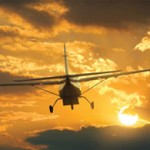LightHawk aviation, a Maine-based consortium of ‘knights of the sky,’ is thinking and acting globally as they commit startling, environmentally good deeds.
By Donna Stuart
It’s a chilly winter morning on the 1,500-mile flight from Virginia as Janice Newman, pilot of the Pilatus PC-12 single-engine turboprop, starts her descent for a refueling stop in Branson, Missouri. On board: fellow pilot Tom Haas and Linda Moore, former senior biologist at the Smithsonian National Zoological Park–and three Mexican wolves, the smallest and most endangered wolf species.
Newman and Haas are volunteer pilots with LightHawk, a nonprofit with deep roots in Maine whose mission is “to champion environmental protection through the unique perspective of flight.” They are delivering the wolves to the Wildlife West Nature Park in Albuquerque, New Mexico, where the two four-year-old females and one eleven-year-old male will live as part of a binational captive breeding program, the Mexican Wolf Species Survival Plan (MWSSP). The goal: a transcontinental “date” across the Basin and Range Province to help reintroduce Mexican wolves into the wild.
Hidden from view, the shy animals lie curled up in deep beds of hay in burlap-covered dog crates set in the rear of the cabin. Moore, the wolves’ caretaker during the flight, detects their growing agitation. She taps Newman on the shoulder, signaling her to slow the descent.
“It’s like they’ve got baby ears. I now know you have to plan the descent so as not to hurt them,” explains Newman, looking back on her first ‘wolf flight’ more than a year ago. Flying out of Portsmouth, New Hampshire, she and Haas have since ferried other Mexican wolves to pre-release facilities in Washington state, Missouri, New York, and Arizona in order to accommodate breeding.
“We do over 1,000 flights each year for hundreds of environmental groups,” says Portland-based Rudy Engholm, LightHawk’s executive director. A former lawyer and long-time environmental activist who lived off the grid for ten years, Engholm founded Northern Wings, an environmental flying service similar to LightHawk, in 1992.
“Doing these kind of flights connects you in a very special way to the land, the creatures, and the issues. When no one knew what a million acres of clear-cut Maine woods looked like, we were able to bring that understanding.” When Northern Wings merged into LightHawk in 2003, Engholm joined LightHawk’s board of directors, becoming its executive director four years later. “There’s such a sense of passion in this organization about what can be accomplished with this tool [the small plane] and great people.”
LightHawk flights, all of which are provided free of charge to LightHawk partners, are either scientific and technical (involving research, data collection, aerial photography, or wildlife transport) or educational, designed to show policy-makers, stakeholders, and the media the consequences of their decisions.
LightHawk flights have enabled Maine Audubon to make an aerial survey of loons on the state’s northern lakes–important since loons in the wild are said to be a barometer measuring the effects of climate change, mercury and lead contamination in lakes, and land lost to development. The organization has also provided dozens of flights to Maine’s land trusts, helping them monitor and better understand the thousands of acres in their care.
While LightHawk isn’t an advocacy group, the issues it helps illuminate often are controversial. Engholm explains, “Whenever you have resource issues that deal with land, you have multiple points of view. A lot of what we do is showing people what’s at stake–and often you can’t do that easily from the ground, whether it’s logging issues or California’s Marine Life Protection Act,” a highly contentious issue that’s had LightHawk flying missions over the state’s coast for the last five years. “From the air, you try to see what unites people–not what divides them. As one official [in California] said, ‘We found common ground in the air.’ Only when they could see it together could they come together.”
LightHawk flies missions all over the U.S., Canada, and south into Central America. Engholm admits that in Mexico planes have been met by armed soldiers, and there are places like southern Panama where the organization won’t fly. Having its small planes mistaken for drug traffickers’ is one risk it won’t take.
Risk is what LightHawk tries to take out of the flying equation. Each flight is meticulously planned; many flights require countless hours of advance planning, securing special permits, working with government agencies, translating documents, and handling all the necessary technical aspects.
According to Engholm, “Our single most complicated flight was probably flying rare Orange-breasted Falcon chicks from Sheraton, Wyoming, to Belize last June.” Since the plane–carrying a biologist, the 42-day-old chicks, and 150 pounds of frozen quail (“the chicks’ in-flight meal”)–wasn’t allowed to stop in Mexico, the turboprop refueled in Texas, a stop which had to be cleared with U.S. Fish and Game. The importance of the birds’ safety was paramount: Fewer than 30 nesting pairs are in Central America today, and a significant percentage of Central America’s Orange-breasted Falcon DNA was on the flight.
The 12-member staff, spread across the U.S. and Mesoamerica, coordinates all the missions flown by nearly 170 volunteer pilots. “We run a decentralized, multi-national [concern] with the number of people who can fit around a family dining table. We try to be judicious about what we do,” Engholm says, noting that LightHawk uses highly efficient aircraft and purchases carbon offsets so the operation is carbon neutral. He estimates this year’s carbon footprint, including staff travel and all mission-related flights, will be about 272 metric tons, assuming 25,000 gallons of aviation fuel. “A single one-way trip from San Francisco to Rio de Janeiro in a 747 would use roughly 40,000 gallons. If society is willing to ‘spend’ these vast amounts of emissions on so many other activities, doesn’t it make sense that we at least invest a small amount of our energy in saving the irreplaceable pieces of wild nature?
“The first rule of intelligent tinkering is to save all the pieces [according to Aldo Leopold in A Sand County Almanac],” concludes Engholm. “That’s the perfect analog for what we do. We try to protect all the pieces of nature–the wildlife, habitats, and diverse ecosystems.”






0 Comments
Trackbacks/Pingbacks